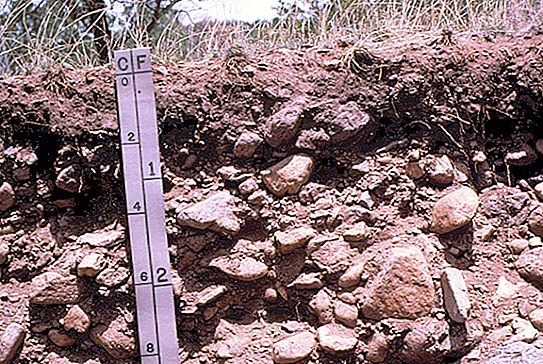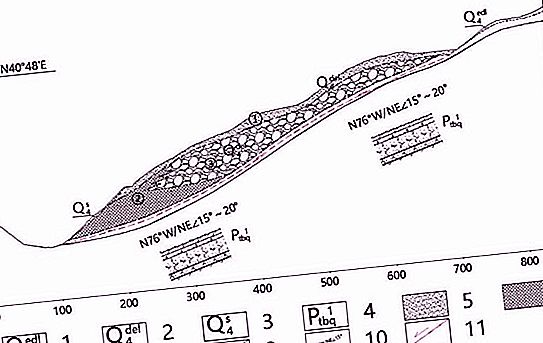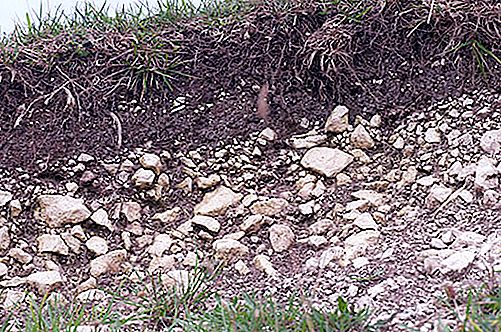Sedimentary rocks form the surface of the earth's crust. Such rocks belong to the Quaternary. They are called sedimentary due to the fact that they are formed as a result of chemical and physical processes, as well as the vital activity of organisms. As a rule, these are deposits of low power, high mobility and poor connectivity.
Sedimentary rocks include:
- eluvial;
- proluvial;
- glacial;
- water-glacial;
- deluvial;
- lake ones;
- loesslike;
- alluvial;
- sea;
- aeolian.
What is eluvium?

Let us consider eluvial deposits in more detail. Eluvium is a rock product formed by weathering and not mechanically displaced. There are a lot of types of this sedimentary material, since there are a large number of rocks, any of which is subject to destruction. In many ways, the composition of eluvium and its power depend on climatic factors and geographical location. In cold or arid conditions, physical weathering predominates. In wet - chemical.
What is weathering?
Weathering, that is, the totality of processes that destroy rocks or minerals, can be physical and chemical. Most often, rocks are exposed to these two types of weathering simultaneously or sequentially. Weathering factors include precipitation, time, temperature, humidity, and the presence of living organisms. If the rocks are loose or there are many cracks in them, then the process of destruction will occur faster.
How to distinguish eluvium?
The main signs of eluvial rocks:
- are at the place of decay of the original rock, while maintaining its frame and filling all the cracks;
- gradually form the source rock;
- uneven lower border;
- consist of clay, ore, metals;
- no division into layers;
- contain particles of different sizes and composition.

How to identify weathering zones by profile?
From the weathering zones, it is possible to determine how eluvium is formed.
The formation of eluvium is as follows. Under the influence of wind, various processes occur that form cracks. Then the cracks expand, and the debris falls down onto the mother rock. Over time, the parent rock appears under a layer of large blocks. A small clastic material fills the free spaces. The upper debris material becomes smaller and can wear out to the smallest particles lining the upper horizon.
Weathering Zones:
- The zone of complete crushing is the uppermost part of the sediment, which is practically impenetrable and ductile due to the presence of clay particles. The zone is composed mainly of small particles of rocks.
- The crushed stone zone is the next after the upper one. It is named so, because of the content in it of detrital material the size of rubble. This zone lets water through, it contains almost no clay particles.
- Block zone - large fragments of the parent rock formed as a result of weathering of cracks. Water permeability is strong. It is important to note that the deeper the larger the debris. If boulders with a diameter of more than a meter can be located below in this zone, then small fragments are most often located above.
- Monolithic zone - the lowest zone, composed only of the parent rock, is an integral layer. Small cracks in the rock are filled with clay material.

Carbonate eluvium
Limestone eluvium is a red-brown rock consisting of clays, loams, detrital material from parent rocks and carbonates. In composition, it resembles the eluvium of a marl, characterized by an even higher content of clay particles. The properties of these two types of rocks include alkalinity, a high content of magnesium and calcium.
Soil on eluvium of limestone and marl
Such soils contain a large number of bases in their composition. They are characterized by low power, since eluvium is a sedimentary material. The advantage of alkaline soils is that they are well drained. However, this can also be a disadvantage in dry periods when plants lack water and minerals.
The presence of debris makes it difficult to process. Due to the content of macronutrients in the soil, humus is formed, which increases fertility. It is due to calcium and magnesium that these eluviums are considered one of the most favorable for use in the temperate and subarctic climatic zones.





